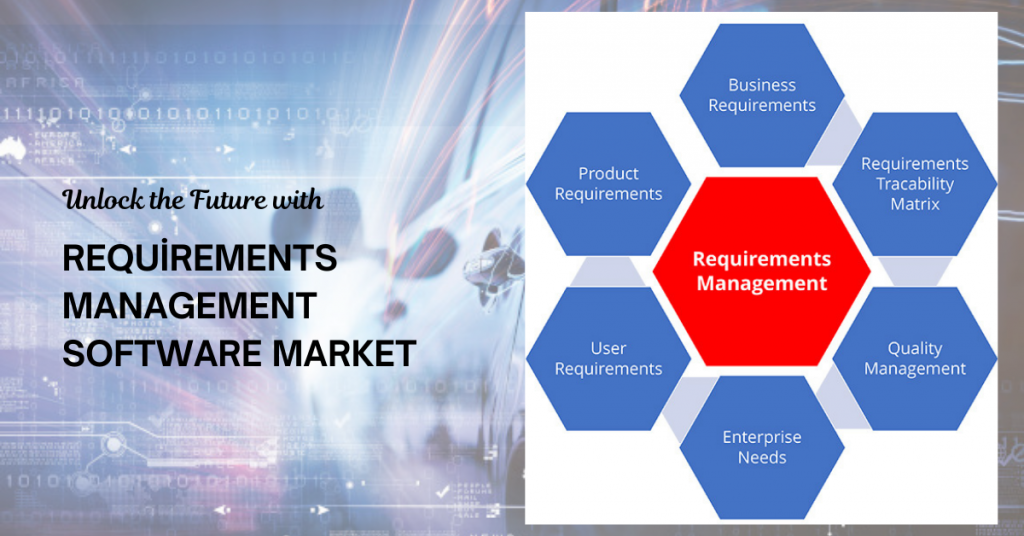
Market Overview
The global Requirements Management Software market is poised for substantial expansion, with its valuation anticipated to escalate from USD 13,765.35 million in 2024 to USD 35,570.8 million by 2032. This growth corresponds to a compound annual growth rate (CAGR) of 12.6%, underscoring the escalating significance of requirement management tools in project execution and software development landscapes worldwide.
As industries face increasingly complex product requirements and faster time-to-market pressures, the imperative for structured and efficient requirement tracking becomes more critical. Requirements management software facilitates meticulous documentation, collaboration, and validation of requirements throughout project phases, minimizing errors and improving compliance rates.
This market gains relevance amid the digital transformation wave sweeping across sectors such as BFSI, healthcare, manufacturing, and telecom. The rise of agile development models further fuels demand for tools capable of real-time requirement updates and stakeholder engagement. The convergence of these factors propels the market into a growth trajectory marked by technological innovation and expanding adoption.
Overall, the Requirements Management Software market stands as a cornerstone technology supporting enterprises’ strategic objectives, risk mitigation efforts, and quality assurance mandates in an increasingly competitive global environment.
Read full report: https://www.credenceresearch.com/report/requirements-management-software-market
Market Drivers
Increasing Complexity of Projects
The rising intricacy of projects in software development, manufacturing, and other sectors demands comprehensive requirement management. For instance, recent studies indicate that over 70% of software projects face delays due to poorly managed requirements. This complexity drives the need for tools that can handle multifaceted project requirements efficiently, boosting the demand for requirements management software. Furthermore, modern projects often involve cross-functional teams working across multiple geographies and time zones, increasing coordination challenges. This scenario necessitates centralized platforms that provide real-time updates and version control to avoid miscommunication. In addition, the integration of emerging technologies like IoT and blockchain introduces new layers of requirements that need precise tracking. Companies that fail to manage these complexities risk cost overruns and subpar deliverables, further emphasizing the importance of robust requirements management solutions. Therefore, the growing intricacy and scale of projects directly fuel the adoption of sophisticated software tools in this space.
Adoption of Agile and DevOps Methodologies
Agile and DevOps frameworks emphasize iterative development and continuous feedback, necessitating real-time and dynamic requirement tracking. Organizations are increasingly integrating requirements management solutions to synchronize team efforts and maintain project transparency. This trend significantly propels market growth as companies strive for faster delivery cycles with minimal errors. Moreover, the shift from traditional waterfall approaches to Agile requires tools that support flexible requirement changes without derailing project timelines. Continuous integration and continuous delivery (CI/CD) pipelines demand seamless communication between development, testing, and operations teams, which requirements management platforms facilitate. These tools also support traceability and impact analysis, helping teams quickly adapt to evolving customer needs. As DevOps culture becomes more pervasive, companies recognize the need for centralized repositories to store and manage requirements, fostering better collaboration. This widespread Agile and DevOps adoption creates a fertile environment for market expansion in requirements management software.
Regulatory Compliance and Risk Management
Strict regulatory environments, especially in healthcare, aerospace, and automotive sectors, require precise documentation and traceability of requirements. Requirements management software facilitates adherence to these regulations by providing audit trails and change management features, mitigating compliance risks and fostering market adoption. For instance, in the pharmaceutical industry, regulations such as FDA 21 CFR Part 11 mandate rigorous documentation of software and system requirements. Failure to comply can lead to hefty fines and product recalls, incentivizing companies to adopt compliant tools. Additionally, such software helps organizations prepare for audits by ensuring all requirements are traceable to design, development, and testing artifacts. This traceability not only reduces legal risks but also enhances quality assurance and customer confidence. As regulations evolve and tighten, industries increasingly rely on automated systems to stay compliant, thus driving demand for requirements management solutions. The growing emphasis on risk mitigation further underscores the software’s strategic importance.
Digital Transformation Initiatives
Enterprises are rapidly embracing digital transformation to improve competitiveness and customer experience. Requirements management software plays a pivotal role by enabling seamless collaboration, automation, and integration across the software development lifecycle, aligning with digital transformation goals and stimulating market expansion. Digital initiatives push organizations to adopt cloud-based, scalable, and interoperable tools, which these software platforms provide. They help break down silos by connecting stakeholders such as business analysts, developers, testers, and clients on a unified platform. Automation features like requirement validation, impact analysis, and workflow management streamline processes, reducing manual errors and accelerating delivery. As companies move towards AI-driven decision-making, requirements management tools integrate predictive analytics to forecast project risks and suggest optimizations. Furthermore, these solutions support mobile and remote workforces, an increasingly important aspect in today’s globalized work environment. This alignment with digital transformation strategies significantly enhances the market potential for requirements management software.
Market Challenges
Integration Complexities
One of the major hurdles in market expansion is integrating requirements management software with legacy systems. Organizations often operate heterogeneous IT environments, making smooth interoperability challenging and costly. Many legacy applications use outdated protocols and data formats, necessitating extensive customization for integration. Additionally, resistance from IT teams accustomed to existing workflows can slow adoption. Seamless data synchronization between old and new systems is crucial but difficult, especially when dealing with proprietary platforms. Integration failures can result in data inconsistencies, duplication, or loss, undermining the software’s value proposition. Vendors must invest in developing flexible APIs and middleware solutions to address these issues. Moreover, prolonged integration cycles increase total cost of ownership, deterring budget-conscious buyers. These technical and organizational challenges represent significant barriers to scaling requirements management solutions across enterprises.
High Initial Investment
Small and medium enterprises (SMEs) face budget constraints that limit their ability to invest in comprehensive requirements management tools. The high initial cost and ongoing maintenance expenses can deter adoption in price-sensitive markets. Besides licensing fees, costs related to training, customization, and system upgrades add to the financial burden. SMEs often prioritize immediate operational needs over strategic investments, delaying software procurement decisions. Additionally, the perceived complexity of such tools may intimidate smaller teams lacking dedicated IT resources. Vendors need to offer flexible pricing models like subscription-based or modular options to accommodate SME budgets. Without addressing affordability and ease of use, market penetration in the SME segment remains limited. This cost barrier also slows adoption in emerging economies where digital budgets are relatively constrained.
Data Security Concerns
With the rise of cloud-based deployments, data privacy and security concerns have escalated. Organizations hesitate to migrate sensitive requirement data to cloud platforms without stringent security assurances, which can slow market penetration. Cyberattacks and data breaches are increasing, raising the stakes for safeguarding intellectual property and compliance data. Regulatory frameworks such as GDPR and HIPAA impose strict data handling rules, demanding robust encryption and access control mechanisms. Many enterprises require on-premises or hybrid deployment options to maintain control over critical data. Vendors must demonstrate strong security certifications and transparent data governance policies to build trust. Furthermore, the complexity of multi-tenant cloud environments can create vulnerabilities that concern security-conscious buyers. Addressing these security challenges is vital for expanding the customer base and enabling cloud adoption.
Lack of Skilled Professionals
Effective utilization of requirements management software demands skilled professionals familiar with both the software and project management principles. The shortage of such expertise can impact the implementation success and overall market growth. Training and onboarding require time and resources, which organizations may struggle to allocate. Without proper knowledge, users may underutilize or misconfigure the software, resulting in poor outcomes. Additionally, the evolving feature sets and integration capabilities demand continuous learning, further taxing available personnel. This talent gap creates a reliance on vendor support and third-party consultants, increasing deployment costs. Academic and professional institutions need to incorporate requirements management tools in their curricula to bridge this gap. Until then, the scarcity of proficient users remains a key market constraint, particularly in less developed regions.
Market Opportunity
Expansion in Emerging Markets
Emerging economies, particularly in Asia Pacific and Latin America, present significant growth opportunities due to increased IT spending and digital adoption. These regions are witnessing rapid infrastructure development and modernization, creating fertile ground for requirements management software deployment. Governments are also pushing for digitization in public services, healthcare, and education, driving demand. Local enterprises are investing in software modernization to enhance operational efficiency and global competitiveness. Furthermore, rising startup ecosystems and SME growth in these markets amplify software requirements. Vendors that tailor solutions to address language, regulatory, and cultural nuances will find competitive advantages. However, awareness and training initiatives are necessary to maximize adoption potential. The untapped nature of these markets positions them as key drivers for sustained industry growth over the next decade.
Cloud-Based Solutions Surge
The growing acceptance of cloud computing offers an excellent opportunity for vendors to expand their user base. Cloud-based solutions provide scalability, cost-effectiveness, and ease of access, appealing to SMEs and large enterprises alike. They eliminate the need for heavy upfront investments in hardware and maintenance. The flexibility to scale resources based on project demands ensures optimized expenditure. Additionally, cloud platforms facilitate global collaboration by enabling real-time access from anywhere, enhancing productivity. Vendors are innovating with Software as a Service (SaaS) models, which support frequent updates and feature rollouts. Integration with other cloud services such as DevOps tools and AI analytics further enhances value propositions. As cloud security improves and compliance certifications become standard, hesitations regarding data safety are diminishing, accelerating adoption.
Integration with AI and Automation
Integrating Artificial Intelligence (AI) and automation capabilities into requirements management software can streamline requirement analysis, defect prediction, and change impact assessment. This integration promises improved accuracy and efficiency, attracting progressive enterprises. AI-powered natural language processing can help in extracting requirements from unstructured data sources, reducing manual effort. Machine learning algorithms can predict potential requirement conflicts and suggest resolutions before development begins. Automation of routine tasks like version control, stakeholder notifications, and compliance checks speeds up workflows and reduces human error. These intelligent features not only improve quality but also enhance decision-making by providing actionable insights. As AI adoption grows across industries, its incorporation into requirements management software becomes a compelling market differentiator.
Vertical-Specific Solutions
Tailoring solutions to specific industries such as BFSI, healthcare, and manufacturing creates a niche market. Industry-specific compliance and functional requirements necessitate customized software offerings, opening avenues for specialized providers. For example, BFSI requires stringent data privacy controls and auditability, while healthcare demands adherence to HIPAA and patient safety standards. Manufacturing benefits from integration with product lifecycle management (PLM) and supply chain systems. Vendors offering modular and configurable platforms that cater to these verticals can address unique pain points effectively. Such targeted approaches enable faster deployment and user adoption by aligning with industry workflows. Moreover, building expertise in vertical-specific regulations and trends enhances vendor credibility and client trust. The shift towards vertical specialization is expected to intensify competition and innovation in the market.
Regional Analysis
North America dominates the requirements management software market, accounting for a significant share due to early technology adoption and the presence of key industry players. The U.S. leads this growth, driven by robust IT infrastructure and widespread implementation across BFSI, healthcare, and government sectors. Canada and Mexico also contribute, supported by increasing investments in digital transformation. The region benefits from a mature software development ecosystem and strong venture capital funding for tech innovation. Additionally, the presence of numerous software giants and startups fosters a competitive market with continuous product enhancements. The adoption of Agile, DevOps, and regulatory requirements such as HIPAA in healthcare further stimulate demand. Strategic partnerships and acquisitions by leading players in North America consolidate their market position, promoting further growth.
Europe holds the second-largest share, propelled by stringent regulatory mandates and high demand from automotive and aerospace industries. The UK and Germany are key contributors, focusing on compliance and quality management. France, Italy, and Spain follow, emphasizing manufacturing and public sector adoption. The European market is characterized by strong emphasis on data protection (GDPR), which influences software feature sets. Collaborative industry initiatives and government digitalization programs also boost demand. Furthermore, Europe’s diverse linguistic and regulatory landscape encourages development of localized solutions, enhancing market penetration. The region’s commitment to Industry 4.0 and smart manufacturing aligns well with advanced requirements management tools, ensuring steady growth.
Asia Pacific is the fastest-growing region, with China, India, and Japan spearheading growth. Rapid industrialization, increasing cloud adoption, and government initiatives for digital governance accelerate market penetration. South Korea and Australia also witness steady demand, fueled by expanding telecom and healthcare sectors. The proliferation of startups and digital natives in these countries drives adoption of innovative software platforms. Government policies promoting smart cities, e-governance, and digital literacy programs underpin long-term growth prospects. However, challenges such as fragmented markets and infrastructure disparities require tailored vendor strategies. Increasing collaborations between local and global players enhance technology transfer and adoption rates in this dynamic region.
Latin America is emerging steadily, with Brazil and Argentina leading investments in IT infrastructure and public sector digitalization. However, challenges like slower technology adoption and budget constraints remain. The region’s growing interest in cloud solutions and remote work setups post-pandemic also spurs demand. Local regulatory changes aiming to improve transparency and efficiency in public services encourage requirements management uptake. Additionally, partnerships with international technology providers facilitate access to advanced tools and training resources. Despite economic fluctuations, the focus on modernization and digital skill development provides a positive outlook for the market.
The Middle East & Africa region exhibits moderate growth, mainly driven by GCC countries and South Africa, focusing on smart city projects and government digital initiatives. Increased demand in oil and gas and telecommunications sectors also stimulates growth. Investments in infrastructure modernization and diversification away from oil dependency propel digital transformation efforts. Countries like the UAE and Saudi Arabia lead smart government programs requiring sophisticated project management tools. Furthermore, regional trade agreements and technology collaborations foster knowledge sharing and market development. Despite geopolitical challenges and uneven economic development, the increasing prioritization of digital infrastructure promises sustained expansion for requirements management software providers.
Top Companies
- IBM
- Blueprint
- Jama Software
- Broadcom
- Goda Software
- Goodwinds
- Aligned Elements
- CaseComplete
- 3SL
- Intland Software
- Accompa
- agileSpecs
Future Outlook
- Increasing adoption of AI-powered requirement analytics will enhance accuracy and speed in requirement gathering.
- Cloud-based deployment models will continue to grow, offering scalable and cost-efficient solutions.
- Integration with Agile and DevOps platforms will become a standard feature, improving workflow alignment.
- Expansion into emerging markets will create new revenue streams for vendors.
- Industry-specific customization will gain momentum, tailoring software to vertical needs.
- Enhanced focus on data security and compliance will drive innovation in encryption and access controls.
- Demand for mobile-enabled requirement management tools will increase to support remote teams.
- Strategic partnerships and acquisitions will shape the competitive landscape.
- User experience and intuitive interfaces will become key differentiators.
- Continuous updates to support evolving regulatory standards will sustain long-term market relevance.
Read full report: https://www.credenceresearch.com/report/requirements-









